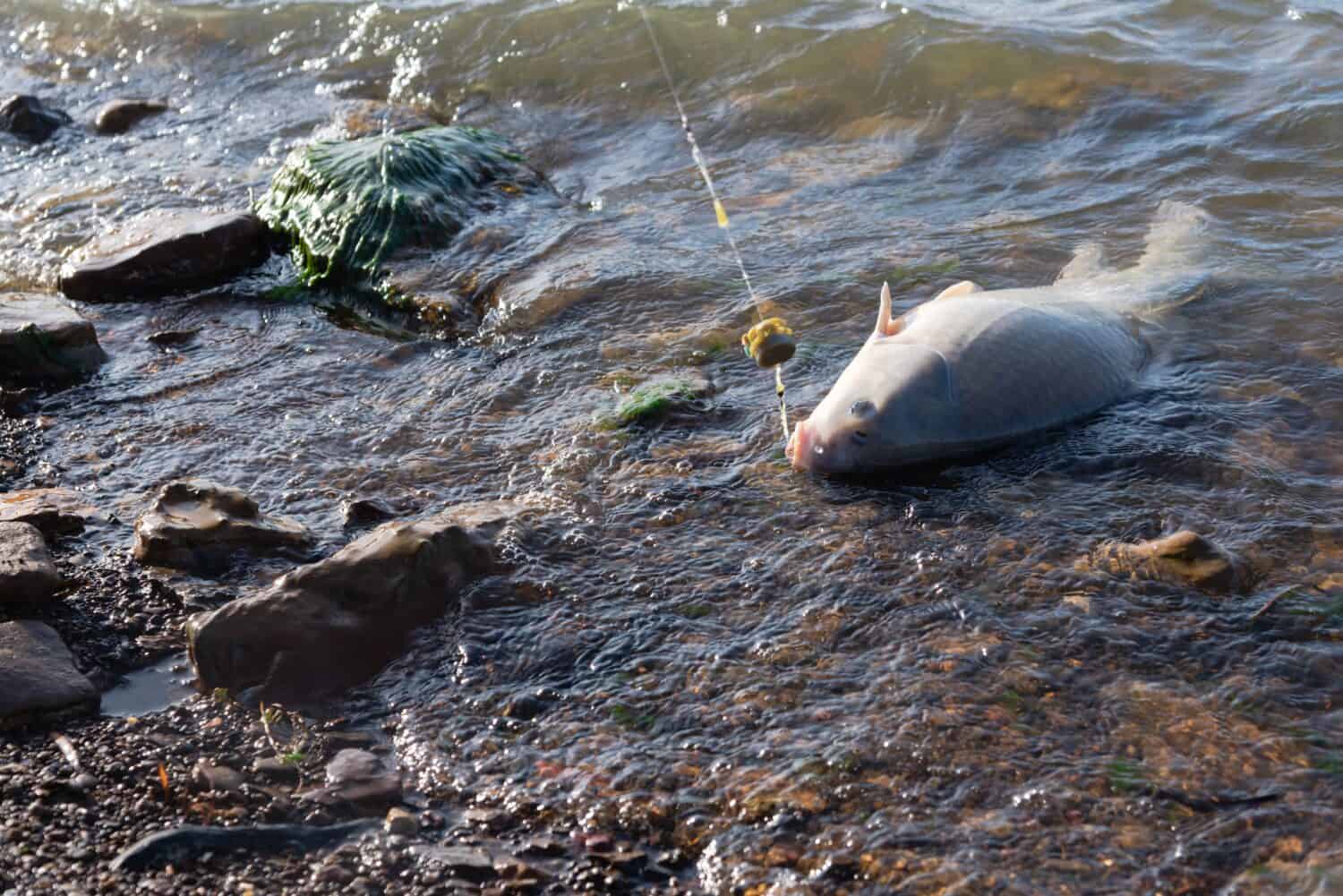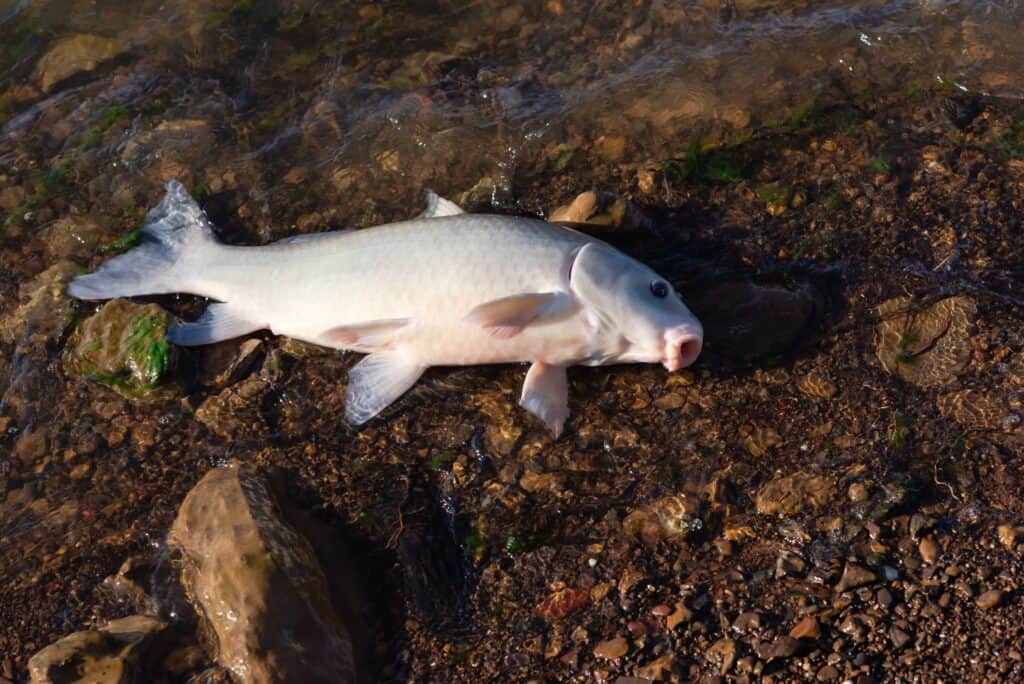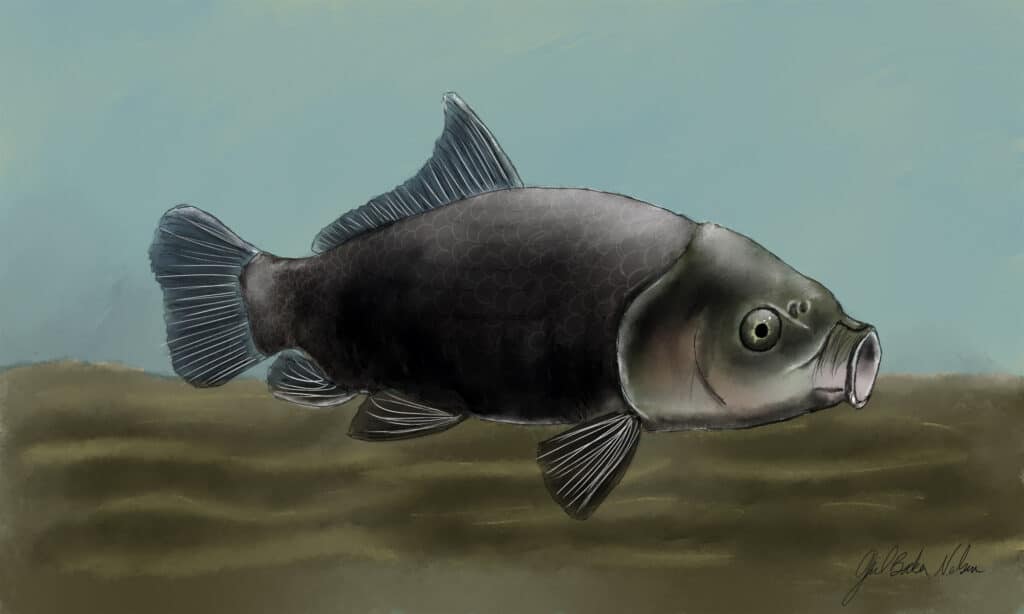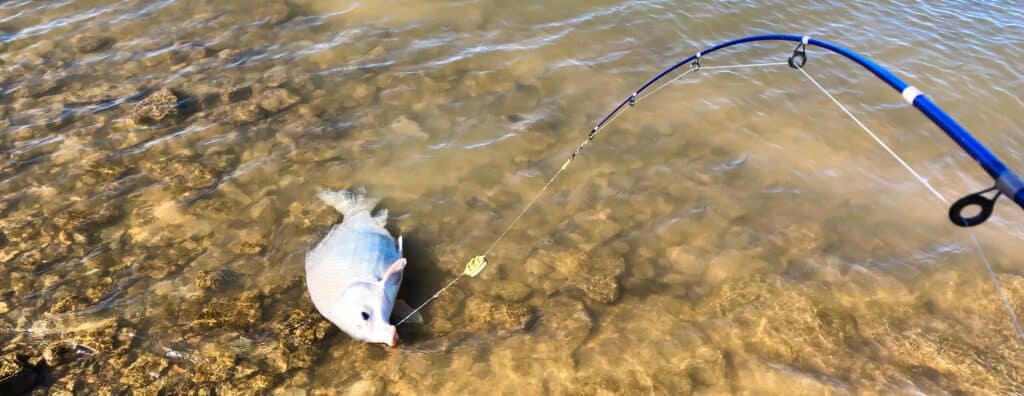As the largest North American species in the suckerfish family, Buffalo fish have started to become more popular among anglers. In the past, many sports fishermen overlooked the Buffalo fish. These fish are tough to hook and strong, rough resisters to reel in. But with the largely unregulated rise in bow fishing, the Buffalo fish is easier to catch.

Let’s look at the largest Buffalo fish ever caught in Michigan!
Description of Buffalo Fish in Michigan

Buffalo fish are the biggest fish in the suckerfish family and are among the longest-living freshwater fishes in the world.
©Trong Nguyen/Shutterstock.com
Native to North America, Buffalo fish belong to the family of Catostomidae or “sucker” fish. In fact, Buffalo fish are the biggest fish in the suckerfish family and are among the longest-living freshwater fishes in the world.
The scientific name of Ictiobus covers a genus of five different species, with the Bigmouth Buffalo fish being the largest in individual size. Ictiobus is Greek, meaning “bull fish,” for how massive this fish genus may grow!
The Five Different Species of Buffalo Fish
There are five different species under the Ictiobus or Buffalo fish genus. They are:

The Smallmouth Buffalo fish can be found in rivers, lakes, and streams throughout North America.
©Trong Nguyen/Shutterstock.com
- Smallmouth Buffalo fish (Ictiobus bubalus)– Bubalus is Greek for “buffalo.” This species lives in tributaries of the Mississippi River ranging from the eastern part of Montana to Pennsylvania and West Virginia. You may also find them in Alabama to the Rio Grande River drainage.
- Bigmouth Buffalo fish (Ictiobus cyprinellus)– Cyprinellus is Latin for “small carp,” even though the Bigmouth is not a type of carp. However, Bigmouth Buffalo and carp look similar. These fish grow up to four feet in length.
- Black Buffalo fish (Ictiobus niger)– Niger is Latin for “dark” or “black.” Found in rivers in eastern North America from Canada to the Mississippi Basin, the Black Buffalo has the darkest complexion of the Buffalo fish.
- Fleshylip Buffalo fish (Ictiobus labiosus)– Labiosus is Latin for “large lips.” This type of ray-finned Buffalo fish lives throughout North America.
- Southern Buffalo fish (Ictiobus meridionalis)– Meridionalis is Latin for “southern.” They mostly dwell in major water systems such as the Hudson Bay and Mississippi River drainages.
Mostly olive in color with combinations of dark gray or golden scales, each species looks a little bit different. For instance, the Southern Buffalo fish is much lighter in hue than the Black Buffalo fish. In general, these fish have broad bodies and blunt heads, and most of them have lower-set mouths for feeding from the bottom of a lake or pond.
Average Buffalo Fish Size
Typically, the Buffalo fish grows to about two feet long. But some have expanded to four feet. These fish can also grow to weigh over 70 pounds! Because of their great size, it is often hard to hook and reel a Buffalo fish in. That is why many fishermen have switched to bow fishing to catch these massive fish.
How Buffalo Fish Reproduce

Buffalo fish spawn in heavily vegetated areas so that the fertilized eggs may attach to surrounding vegetation.
©Rostislav Stefanek/Shutterstock.com
Around three to 30 spawning groups of Buffalo fish may gather in one breeding area. About three to five fish make up each unit. A female will be in the center, with two to four males surrounding her. The female will sink to the bottom of a well-vegetated area of a lake or pond. Then, after depositing the eggs, the female rises to the surface, and the males release reproductive milt over the eggs. Simultaneously, the female will thrash her tail about, making waves that mix the eggs and milt together. Then, the fertilized eggs free-float until they attach to surrounding vegetation.
Diet

Buffalo fish are omnivores and eat plants and animals such as plankton, algae, insects and insect larvae, small crustaceans, as well as a range of other aquatic plants. But in general, they will eat almost anything they can swallow. As the Buffalo fish is sucking in mouthfuls of sand, its body will filter out the edible parts, and the rest of the debris flushes through its digestive system and exits the body.
Habitat

Slow-moving water with temperate temperatures is ideal for Buffalo fish. In fact, the largest Buffalo fish in Michigan was caught in Lake Erie, the lake featured here.
©IanSkylake17/Shutterstock.com
Buffalo fish live throughout the United States, Mexico, Guatemala, and Canada. They prefer shallow, slow water systems where they can filter through the muddy substrate for food. This could include ponds, lakes, creeks, and other environments that are freshwater with temperate temperatures.
Buffalo fish also prefer water with many aquatic plants and vegetation as they use this cover to house their eggs.
Lifespan
Scientists have used the otoliths of buffalo fish and bomb-radiocarbon dating to discover the long lifespan of these fish. Otoliths, or “earstones,” are the calcium carbonate structures that sit behind the brain of bony fish. Researchers commonly thought that Buffalo fish only live about 30 to 40 years. However, using this technique of bomb-radiocarbon dating, scientists discovered that Buffalo fish can live up to 112 years old!
Fishing for a Buffalo Fish

Using an alternative bow fishing method proved to be wise in catching the largest Bigmouth buffalo in Michigan.
©Christopher Moswitzer/Shutterstock.com
Rarely do people catch a Buffalo fish with a hook and line. But, with bow fishing gaining popularity, this has made Buffalo fish easier to catch and a highly prized type of sport fish in many areas. Many people liken the taste of Buffalo fish to chicken. Even though it’s a very bony fish to eat, some enjoy the challenge of eating a Buffalo fish.
Recently, fishermen will take their specialized bows and arrows to hunt these fish at night. Using a bright light in shallow waters, fishermen draw the Buffalo fish to the surface. Once the fish is visible, fishermen spear them with their bow and arrow. Unfortunately, authorities have yet to conduct studies on how the powerful lights or increased harvesting have affected this genus of fish.
This type of fishing is largely unregulated in 19 of 22 states where Buffalo fish are native. In these states, fishermen may catch as many Buffalo fish as they want. However, states like Missouri and Louisiana regulate the number of Buffalo fish caught. In Pennsylvania, it is illegal to possess a Buffalo fish, and the species is considered endangered.
The Largest Buffalo Fish Ever Caught in Michigan

Anglers enjoy fishing for Buffalo fish, as they are challenging to catch and great to eat, despite being very bony fish.
©Trong Nguyen/Shutterstock.com
Only two of the five species of Buffalo fish are in the record books in Michigan. The biggest Bigmouth Buffalo fish caught in Michigan was 33 pounds. It was 36.25 inches long. Caught in 2020 using the bow fishing method, this massive fish was captured in Lake Erie in Monroe County.
The other record-breaking fish was the Black Buffalo fish, also caught in 2020. It weighed 54.3 pounds and was 42.6 inches long. Surprisingly, this huge fish was caught using the trolling method of fishing. That is when one or more lines are baited with fish or lures and dragged through the water. In this instance, the fisherman used a Hot ‘N’ Tot lure. This Black Buffalo fish was caught in the Grand River in Ottawa County.
According to the International Game Fish Association, the biggest all-tackle record for a Bigmouth Buffalo was caught on April 21, 1980. This beast weighed 70.3 pounds! Delbert Sisk captured this prized fish in Bastrop, Louisiana.
The photo featured at the top of this post is © Trong Nguyen/Shutterstock.com
Thank you for reading! Have some feedback for us? Contact the AZ Animals editorial team.






